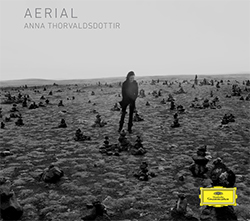 It’s a while since i’ve had a chance to survey new releases, so there’s quite a few that are overdue being highlighted. Some of them appeared on my recent Best Albums of the Year list, such as Anna Thorvaldsdottir‘s Aerial, out on Deutsche Grammophon. As i’ve mentioned in my previous articles about Thorvaldsdottir’s work, her overtly elemental music thrives in establishing environments where elements of certainty are both undermined and consolidated. Orchestral work Aeriality is a superbly lucid example of this, a work that seemingly keeps trying to reset itself via strong intervals like octaves, fourths and fifths, which are repeatedly overrun and infiltrated by tendrils of material, leading to fascinating passages of grey, almost blank obfuscation (a Thorvaldsdottir fingerprint). Much of her work explores this friction between clarity and obscurity, variously weighted, and most of the works heard here begin shrouded in abstraction. But what’s so very refreshing about this is the absence of clichéd value associations: clarity here is no more positive a thing than its opposite. The interest, and it is considerable, lies in the juxtapositions and steady evolutions between states, a connotative mirror—if one wishes to see it as such—of Thorvaldsdottir’s Icelandic heritage but just as much a liberated celebration of the primordial plasticity of sound.
It’s a while since i’ve had a chance to survey new releases, so there’s quite a few that are overdue being highlighted. Some of them appeared on my recent Best Albums of the Year list, such as Anna Thorvaldsdottir‘s Aerial, out on Deutsche Grammophon. As i’ve mentioned in my previous articles about Thorvaldsdottir’s work, her overtly elemental music thrives in establishing environments where elements of certainty are both undermined and consolidated. Orchestral work Aeriality is a superbly lucid example of this, a work that seemingly keeps trying to reset itself via strong intervals like octaves, fourths and fifths, which are repeatedly overrun and infiltrated by tendrils of material, leading to fascinating passages of grey, almost blank obfuscation (a Thorvaldsdottir fingerprint). Much of her work explores this friction between clarity and obscurity, variously weighted, and most of the works heard here begin shrouded in abstraction. But what’s so very refreshing about this is the absence of clichéd value associations: clarity here is no more positive a thing than its opposite. The interest, and it is considerable, lies in the juxtapositions and steady evolutions between states, a connotative mirror—if one wishes to see it as such—of Thorvaldsdottir’s Icelandic heritage but just as much a liberated celebration of the primordial plasticity of sound.
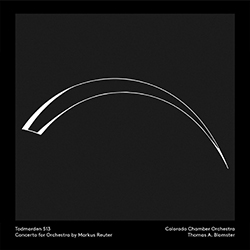 Another of my best albums of 2014 is Todmorden 513 by German composer Markus Reuter, which could almost be described as an essay in carefully orchestrated bafflement. Its prefix is taken from a small town in Yorkshire, with interesting lexical connotations to both death and murder, while its more obviously-connected suffix refers to the “sequence of five hundred and thirteen harmonies and triads generated by a combinatorial compositional technique”. Applied to an orchestra (performed by the Colorado Chamber Orchestra), the result is highly paradoxical, directly blurring the distinction between process and chance (in part due to the work’s slow progression) and between consonance and dissonance. The overriding sense is of a vertical focus constructed from the gradual forward motion of independent horizontal lines, causing a continual harmonic flux; many’s the time that the suggestion of a familiar chord progression might present itself, but it’s always an illusion, as are its sporadic implications of cadence. All of this establishes an acutely vibrant relationship with the listener that, with infinite gentleness, strips away any and all preconceptions one brings to it with the sharp acerbity of a palate cleanser. What remains is entirely enigmatic, in some ways redolent of Feldman (but that’s rather too easy and superficial a connection to make) but really sounding like nothing other than itself, a beautifully coloured and shaded alien artifact.
Another of my best albums of 2014 is Todmorden 513 by German composer Markus Reuter, which could almost be described as an essay in carefully orchestrated bafflement. Its prefix is taken from a small town in Yorkshire, with interesting lexical connotations to both death and murder, while its more obviously-connected suffix refers to the “sequence of five hundred and thirteen harmonies and triads generated by a combinatorial compositional technique”. Applied to an orchestra (performed by the Colorado Chamber Orchestra), the result is highly paradoxical, directly blurring the distinction between process and chance (in part due to the work’s slow progression) and between consonance and dissonance. The overriding sense is of a vertical focus constructed from the gradual forward motion of independent horizontal lines, causing a continual harmonic flux; many’s the time that the suggestion of a familiar chord progression might present itself, but it’s always an illusion, as are its sporadic implications of cadence. All of this establishes an acutely vibrant relationship with the listener that, with infinite gentleness, strips away any and all preconceptions one brings to it with the sharp acerbity of a palate cleanser. What remains is entirely enigmatic, in some ways redolent of Feldman (but that’s rather too easy and superficial a connection to make) but really sounding like nothing other than itself, a beautifully coloured and shaded alien artifact.
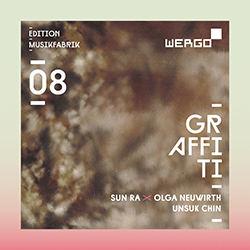 Switching to somewhat smaller forces, the most wonderfully diverse CD i’ve heard lately comes from Ensemble Musikfabrik; Graffiti (Wergo) brings together Unsuk Chin and Olga Neuwirth with a pair of Sun Ra arrangements. The title work by Chin sounds like a new chapter in her compositional outlook, in which her familiar filigree is now strongly countered by leftfield harmonic episodes, the earliest of which sounds like an oblique chorale, while a later example is more ambiguous, like floating cadences in want of a progression. Anyone who’s found Chin’s earlier work too ephemeral or bejewelled with detail may find Graffiti very much more engaging. Olga Neuwirth’s trumpet concerto …Miramondo Multiplo… (dazzlingly performed by Marco Blauuw) is a veritable cavalcade of moods, atmospheres and allusions. The trumpet essentially rides atop the thoroughly boistrous ensemble, pausing for numerous asides—enchanted, melancholic, animalistic—occasionally becoming subsumed in the prevailing textures around it, more often than not steering everything through a sequence of episodes evoking various other composers. Sondheim’s ‘Send in the Clowns’ and Handel’s ‘Lascia ch’io pianga’ make notable appearances, the former an amusing but otherwise seemingly congruous climax, the latter an eerie but rather gorgeous meditation, full of distortions and wistful moments of ecstasy. Of the two Sun Ra works, Outer Nothingness is the more convincing; the other, Pleiades, features Sun Ra’s voice amidst the restrained, at times clogged, ensemble textures that provide for it a loose context that nonetheless feels a little too much like a manifesto. But Outer Nothingness is a triumph of barely-controlled chaos: wailing brass and drums everywhere leading to outbursts of free improvisation and convoluted counterpoint, culminating in a sudden onslaught of huge proportions tempered with a curiously tentative ending. Just wonderful.
Switching to somewhat smaller forces, the most wonderfully diverse CD i’ve heard lately comes from Ensemble Musikfabrik; Graffiti (Wergo) brings together Unsuk Chin and Olga Neuwirth with a pair of Sun Ra arrangements. The title work by Chin sounds like a new chapter in her compositional outlook, in which her familiar filigree is now strongly countered by leftfield harmonic episodes, the earliest of which sounds like an oblique chorale, while a later example is more ambiguous, like floating cadences in want of a progression. Anyone who’s found Chin’s earlier work too ephemeral or bejewelled with detail may find Graffiti very much more engaging. Olga Neuwirth’s trumpet concerto …Miramondo Multiplo… (dazzlingly performed by Marco Blauuw) is a veritable cavalcade of moods, atmospheres and allusions. The trumpet essentially rides atop the thoroughly boistrous ensemble, pausing for numerous asides—enchanted, melancholic, animalistic—occasionally becoming subsumed in the prevailing textures around it, more often than not steering everything through a sequence of episodes evoking various other composers. Sondheim’s ‘Send in the Clowns’ and Handel’s ‘Lascia ch’io pianga’ make notable appearances, the former an amusing but otherwise seemingly congruous climax, the latter an eerie but rather gorgeous meditation, full of distortions and wistful moments of ecstasy. Of the two Sun Ra works, Outer Nothingness is the more convincing; the other, Pleiades, features Sun Ra’s voice amidst the restrained, at times clogged, ensemble textures that provide for it a loose context that nonetheless feels a little too much like a manifesto. But Outer Nothingness is a triumph of barely-controlled chaos: wailing brass and drums everywhere leading to outbursts of free improvisation and convoluted counterpoint, culminating in a sudden onslaught of huge proportions tempered with a curiously tentative ending. Just wonderful.
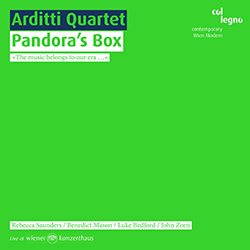 Reducing in scale even further, Pandora’s Box, a new CD by the Arditti Quartet on Col Legno, features four very striking works, two of which are recorded here for the first time. Both Rebecca Saunders’ Fletch and John Zorn’s Pandora’s Box have been performed by the Ardittis at the Huddersfield Contemporary Music Festival in recent years (my reviews are here and here). Fletch sounds as flighty and uncatchable as ever, the quartet articulating both all-or-nothing material and dynamics, acting as a single entity. Spontaneous tangible pitches become worked into the music’s edgy effervescence, but do nothing to alter its basic behaviour: withdrawn, slow, tenebral—and, i should say, gorgeous. Benedict Mason’s Second String Quartet initially sounds like the surface of water, dense and rapid, details passing faster than they can be glimpsed; this is largely as interesting as it gets, descending into lengthy, frustratingly distant, discourse (being charitable, it is at least counter-intuitive). Luke Bedford’s Wonderful Four-Headed Nightingale charts an intriguing transition from brusque warm-up proclivities to refined melodic elegance—only then to come undone, trammelled material leading to a retreat back to first principles; the extreme contrasts here are deeply telling. Peerless soprano Sarah Maria Sun joins the quartet for the Zorn, her relationship sometimes guiding them on while elsewhere content simply to inhabit the sonic climates they create. In many of Zorn’s works featuring solo soprano he relishes pushing the voice into its most stratospheric range, which he does here, often the apex of wild, angular lines. Far more arresting, though, is the remarkable episode towards the end coaxing the soprano down into the depths, attaining a magical quality, as though entranced, casting a spell that causes everything to hush.
Reducing in scale even further, Pandora’s Box, a new CD by the Arditti Quartet on Col Legno, features four very striking works, two of which are recorded here for the first time. Both Rebecca Saunders’ Fletch and John Zorn’s Pandora’s Box have been performed by the Ardittis at the Huddersfield Contemporary Music Festival in recent years (my reviews are here and here). Fletch sounds as flighty and uncatchable as ever, the quartet articulating both all-or-nothing material and dynamics, acting as a single entity. Spontaneous tangible pitches become worked into the music’s edgy effervescence, but do nothing to alter its basic behaviour: withdrawn, slow, tenebral—and, i should say, gorgeous. Benedict Mason’s Second String Quartet initially sounds like the surface of water, dense and rapid, details passing faster than they can be glimpsed; this is largely as interesting as it gets, descending into lengthy, frustratingly distant, discourse (being charitable, it is at least counter-intuitive). Luke Bedford’s Wonderful Four-Headed Nightingale charts an intriguing transition from brusque warm-up proclivities to refined melodic elegance—only then to come undone, trammelled material leading to a retreat back to first principles; the extreme contrasts here are deeply telling. Peerless soprano Sarah Maria Sun joins the quartet for the Zorn, her relationship sometimes guiding them on while elsewhere content simply to inhabit the sonic climates they create. In many of Zorn’s works featuring solo soprano he relishes pushing the voice into its most stratospheric range, which he does here, often the apex of wild, angular lines. Far more arresting, though, is the remarkable episode towards the end coaxing the soprano down into the depths, attaining a magical quality, as though entranced, casting a spell that causes everything to hush.
 Irish pianist Mary Dullea explores the music of Eric Craven on a double CD of piano sonatas released a few months back by Metier. Craven’s work involves varying quantities of choice and freedom on the part of the performer, via a system of ‘non-prescriptive’ notation. Some of these are still mostly notated, whereas others (the ‘middle-order’ and especially ‘low-order’ variants) provide little more than unordered fragments of musical material, inviting the player to forge a unique interpretation of order from Craven’s initial chaos. Dullea’s renditions are fascinating; Sonata #7 gradually moves from a kind of quasi Steve Martland cyclic noodling into a really lovely spacious music, staccato notes laid over extended resonances beneath. Here and elsewhere, Dullea’s combination of spritely yet fastidious playing imbues Craven’s material with a palpable sense of personification, heightening the impression of (imagined) underlying drama. Sonata #9 speaks with less confidence, its Romantic flavour and sense of searching causing the material to meander, losing focus; even the central movement, with its Finnissy-esque cascading torrents of notes (Dullea’s playing is amazing here), retains a kind of aimlessness. It falls to the final movement (which bears similarities to George Benjamin’s Piano Sonata) to find real rigour, scrutinising motifs and melodic cells, at times almost obsessively. Sonata #8, occupying the entire second disc, is deeply compelling, immediate conveying the idea of something being argued; Mary Dullea deserves serious kudos for navigating so convincingly through the free-floating material). The piece displays a tenderness not glimpsed elsewhere, and is actually rather moving; the music’s unique kind of structure perhaps projects psychological aspects more forcefully to the surface. Music involving this kind of freedom runs the risk of sounding provisional, but Dullea’s renditions seem—although this is an obvious contradiction—definitive, which for composer and performer alike is a far from slight achievement.
Irish pianist Mary Dullea explores the music of Eric Craven on a double CD of piano sonatas released a few months back by Metier. Craven’s work involves varying quantities of choice and freedom on the part of the performer, via a system of ‘non-prescriptive’ notation. Some of these are still mostly notated, whereas others (the ‘middle-order’ and especially ‘low-order’ variants) provide little more than unordered fragments of musical material, inviting the player to forge a unique interpretation of order from Craven’s initial chaos. Dullea’s renditions are fascinating; Sonata #7 gradually moves from a kind of quasi Steve Martland cyclic noodling into a really lovely spacious music, staccato notes laid over extended resonances beneath. Here and elsewhere, Dullea’s combination of spritely yet fastidious playing imbues Craven’s material with a palpable sense of personification, heightening the impression of (imagined) underlying drama. Sonata #9 speaks with less confidence, its Romantic flavour and sense of searching causing the material to meander, losing focus; even the central movement, with its Finnissy-esque cascading torrents of notes (Dullea’s playing is amazing here), retains a kind of aimlessness. It falls to the final movement (which bears similarities to George Benjamin’s Piano Sonata) to find real rigour, scrutinising motifs and melodic cells, at times almost obsessively. Sonata #8, occupying the entire second disc, is deeply compelling, immediate conveying the idea of something being argued; Mary Dullea deserves serious kudos for navigating so convincingly through the free-floating material). The piece displays a tenderness not glimpsed elsewhere, and is actually rather moving; the music’s unique kind of structure perhaps projects psychological aspects more forcefully to the surface. Music involving this kind of freedom runs the risk of sounding provisional, but Dullea’s renditions seem—although this is an obvious contradiction—definitive, which for composer and performer alike is a far from slight achievement.
 The latest volume in the Stradivarius label’s ongoing exploration of Giacinto Scelsi‘s work features the composer’s small-scale works involving the flute family, all performed by Roberto Fabbriciani. Dating from two distinct periods in the 1950s and mid-1970s, they demonstrate a compelling, differentiated attitude toward both the treatment of ideas as well as the harmonic freedom or otherwise of melodic lines. Maknongan—heard on both the bass flute and seriously dour octobass flute—constitutes an extreme of sorts, adopting a single-minded, unwavering position dominated by a central pitch. Quays also features a dominant pitch that acts to an extent as a ‘tonic’, in relation to which the flute’s florid melody is heard. This is also a characteristic of Hyxos for alto flute, two gongs and cowbell, where the sense of a ‘tonic’ pervades the first and third movements, resulting in a captivating kind of quasi-diatonic writing that sounds almost Far Eastern (enhanced by the use of resonant percussion). Pwyll for solo flute presents a series of ideas and then sets about developing them, focusing on one at a time and attacking it from different angles. But the high point of the disc is Tetratkys (also for solo flute), which at first makes up for increased harmonic freedom with a drastically reduced bandwith, filling it with borderline manic material only partly tempered by a pensive shift later on; ultimately, the piece displays a freedom in contrast to everything that preceded it, as well as a ferocity of utterance in the final movement’s passages of high virtuosity, the notes practically spat out with unfettered jubilation.
The latest volume in the Stradivarius label’s ongoing exploration of Giacinto Scelsi‘s work features the composer’s small-scale works involving the flute family, all performed by Roberto Fabbriciani. Dating from two distinct periods in the 1950s and mid-1970s, they demonstrate a compelling, differentiated attitude toward both the treatment of ideas as well as the harmonic freedom or otherwise of melodic lines. Maknongan—heard on both the bass flute and seriously dour octobass flute—constitutes an extreme of sorts, adopting a single-minded, unwavering position dominated by a central pitch. Quays also features a dominant pitch that acts to an extent as a ‘tonic’, in relation to which the flute’s florid melody is heard. This is also a characteristic of Hyxos for alto flute, two gongs and cowbell, where the sense of a ‘tonic’ pervades the first and third movements, resulting in a captivating kind of quasi-diatonic writing that sounds almost Far Eastern (enhanced by the use of resonant percussion). Pwyll for solo flute presents a series of ideas and then sets about developing them, focusing on one at a time and attacking it from different angles. But the high point of the disc is Tetratkys (also for solo flute), which at first makes up for increased harmonic freedom with a drastically reduced bandwith, filling it with borderline manic material only partly tempered by a pensive shift later on; ultimately, the piece displays a freedom in contrast to everything that preceded it, as well as a ferocity of utterance in the final movement’s passages of high virtuosity, the notes practically spat out with unfettered jubilation.
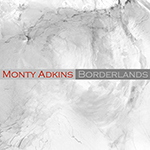
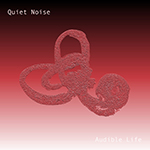 Turning to electronic music, there’s a pair of interesting new releases from the Audiobulb label. Monty Adkins‘ latest offering, released a couple of weeks ago, is a 37-minute drone piece for cello and electronics titled Borderlands. While not as immersive as some of his recent work (although that may be due to home listening rather than in a concert space), it’s no less refined; in the last few years Adkins, more than most, has brought real elegance to electronic music, a quality all too absent from most contemporary ambient. A digital only release, it’s available in both 16- and 24-bit editions. And coming in a few weeks is Audible Life, a new album by Quiet Noise, the moniker for British composer/sound engineer Adam Wilkinson. The textures are light and playful, but there’s a recurring undercurrent of seriousness that rears its head in moments of introspection. They prevent Audible Life from becoming a victim of its own whimsy, and imprint an authentically human presence throughout all the ostensibly aloof clockwork mechanisms and loops.
Turning to electronic music, there’s a pair of interesting new releases from the Audiobulb label. Monty Adkins‘ latest offering, released a couple of weeks ago, is a 37-minute drone piece for cello and electronics titled Borderlands. While not as immersive as some of his recent work (although that may be due to home listening rather than in a concert space), it’s no less refined; in the last few years Adkins, more than most, has brought real elegance to electronic music, a quality all too absent from most contemporary ambient. A digital only release, it’s available in both 16- and 24-bit editions. And coming in a few weeks is Audible Life, a new album by Quiet Noise, the moniker for British composer/sound engineer Adam Wilkinson. The textures are light and playful, but there’s a recurring undercurrent of seriousness that rears its head in moments of introspection. They prevent Audible Life from becoming a victim of its own whimsy, and imprint an authentically human presence throughout all the ostensibly aloof clockwork mechanisms and loops.
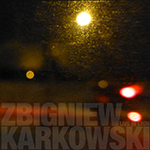
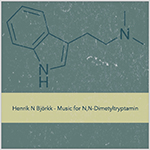 A year after his death, the late lamented Zbigniew Karkowski is commemorated with Live in Lyon, an unedited soundboard recording from an undated live performance. The 23-minute piece is a typically intensive engagement with noise materials, exploring vastly different regions of the sound domain, flitting ad libitum between mono and stereo fields. It’s an exhilarating demonstration of Karkowski’s skill at manipulating and marshalling raw turbulence, made all the more expressive through being an obviously live recording. Best of all, it’s available as a free download courtesy of the Walnut+Locust label. Also available free is Music for N,N-Dimetyltryptamin by Henrik N Björkk (aka Nordvargr). Like Wermland Atonal 1, one of my favourite EPs of 2014, this is a total contrast to Nordvargr’s blacker-than-black ambient. Here, raw electronics are seemingly recorded at play without human intervention, encompassing dense networks of intricate tracery, unpredictable burps and squelches, prolonged drones adorned and reinforced with diverse sonic accretions and juddering pulsations of light and colour.
A year after his death, the late lamented Zbigniew Karkowski is commemorated with Live in Lyon, an unedited soundboard recording from an undated live performance. The 23-minute piece is a typically intensive engagement with noise materials, exploring vastly different regions of the sound domain, flitting ad libitum between mono and stereo fields. It’s an exhilarating demonstration of Karkowski’s skill at manipulating and marshalling raw turbulence, made all the more expressive through being an obviously live recording. Best of all, it’s available as a free download courtesy of the Walnut+Locust label. Also available free is Music for N,N-Dimetyltryptamin by Henrik N Björkk (aka Nordvargr). Like Wermland Atonal 1, one of my favourite EPs of 2014, this is a total contrast to Nordvargr’s blacker-than-black ambient. Here, raw electronics are seemingly recorded at play without human intervention, encompassing dense networks of intricate tracery, unpredictable burps and squelches, prolonged drones adorned and reinforced with diverse sonic accretions and juddering pulsations of light and colour.
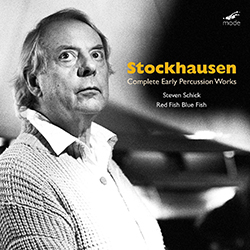 Finally, to some extent uniting both instrumental and electronic forces is a wonderful new double-CD of Karlheinz Stockhausen‘s Complete Early Percussion Works (Mode). These five substantial works reveal anew the breadth and multi-faceted nature of Stockhausen’s compositional imagination. The earliest of them, the Schlagtrio from 1952, is the least inviting, its episodes of heavily accented pitches on piano and timpani betraying a sense of arbitrariness—but it does at least attain the quality of an esoteric ritualistic act, which keeps things (relatively) interesting. The same can be said of Steven Schick’s rendition of Zyklus, which although far more beautiful has a kind of exclusive nature, as though we were listening in on a private performance. Refrain—composed in the same year, 1959—is a glorious study in carefully-placed resonance, comprising vibraphone, piano and (shouted) voices. Stark initial juxtapositions develop into more intricate passagework, and the recurring vocal exclamations add an immense frisson of exuberance to the music’s rarified soundworld. The indisputable highlights, though, are the performances of Kontakte and Mikrophonie, which are arguably the most memorable and impactful that i’ve yet encountered; indeed, Kontakte (for piano, percussion and 4-channel tape) has perhaps never sounded better, the recording using new digital transfers from the original analogue master tapes. Completed in 1960, Kontakte still sounds formidably modern, Stockhausen’s superlative command of synthetic sounds dispelling any notions that there is something primitive or restrictive about early electronic music. Despite being so extremely abstract (perhaps the work’s most defining characteristic), it is highly engaging—never seeking (or needing) to evoke or allude, it instead delights in the sheer joy of sound itself. And it’s hard to not to hear a prefiguring of contemporary drone and ambient music in the work’s expansive central episode. Stockhausen’s penchant for the fantastical has rarely sounded so marvellous. Mikrophonie, too, sounds shockingly new despite now being 50 years old. Performed here by percussion ensemble red fish blue fish, its extensive integration of acoustic sounds and electronic treatment is, literally, amazing to behold, the plethora of actions wrought on the massive tam-tam transformed into a bewildering, ground-breaking study of what both sound and music are capable of. One of those rare releases that genuinely deserves to be described as ‘essential’, anyone wanting to ramp up the enjoyment to levels of pure delirium can opt for a DVD version with assorted bonus features.
Finally, to some extent uniting both instrumental and electronic forces is a wonderful new double-CD of Karlheinz Stockhausen‘s Complete Early Percussion Works (Mode). These five substantial works reveal anew the breadth and multi-faceted nature of Stockhausen’s compositional imagination. The earliest of them, the Schlagtrio from 1952, is the least inviting, its episodes of heavily accented pitches on piano and timpani betraying a sense of arbitrariness—but it does at least attain the quality of an esoteric ritualistic act, which keeps things (relatively) interesting. The same can be said of Steven Schick’s rendition of Zyklus, which although far more beautiful has a kind of exclusive nature, as though we were listening in on a private performance. Refrain—composed in the same year, 1959—is a glorious study in carefully-placed resonance, comprising vibraphone, piano and (shouted) voices. Stark initial juxtapositions develop into more intricate passagework, and the recurring vocal exclamations add an immense frisson of exuberance to the music’s rarified soundworld. The indisputable highlights, though, are the performances of Kontakte and Mikrophonie, which are arguably the most memorable and impactful that i’ve yet encountered; indeed, Kontakte (for piano, percussion and 4-channel tape) has perhaps never sounded better, the recording using new digital transfers from the original analogue master tapes. Completed in 1960, Kontakte still sounds formidably modern, Stockhausen’s superlative command of synthetic sounds dispelling any notions that there is something primitive or restrictive about early electronic music. Despite being so extremely abstract (perhaps the work’s most defining characteristic), it is highly engaging—never seeking (or needing) to evoke or allude, it instead delights in the sheer joy of sound itself. And it’s hard to not to hear a prefiguring of contemporary drone and ambient music in the work’s expansive central episode. Stockhausen’s penchant for the fantastical has rarely sounded so marvellous. Mikrophonie, too, sounds shockingly new despite now being 50 years old. Performed here by percussion ensemble red fish blue fish, its extensive integration of acoustic sounds and electronic treatment is, literally, amazing to behold, the plethora of actions wrought on the massive tam-tam transformed into a bewildering, ground-breaking study of what both sound and music are capable of. One of those rare releases that genuinely deserves to be described as ‘essential’, anyone wanting to ramp up the enjoyment to levels of pure delirium can opt for a DVD version with assorted bonus features.

Careful, Simon! That’s the second time you’ve done it: historically, Todmorden was Lancastrian, and its inhabitants are still defiantly “red rose”, some even going as far as adopting a Horrocks-esque E Lancs burr to emphasise the point (see also the dangerous ground one treads on by placing Saddleworth folk anywhere other than in Yorkshire, now-decades-old administrative boundaries notwithstanding).
But what a fascinating selection of albums, headed, of course, by my beloved Anna! I shall certainly investigate those of them that are Spotifiable, if nothing else.
One further thought: given your love of the electronic side of pop, I’d recommend giving Indiana’s No Romeo a listen. Quite apart from the inventiveness of some of her arrangements and song structures, she’s got a very distinctive voice: Beth Gibbons from Portishead meets Florence “Against the Machine” Welch? And while I’m at it, there have been considerably less worthy Mercury Music Prize winners than Young Fathers’ DEAD.
Thanks for the suggestion, Chris; I’ll certainly check out it out!
Thanks for a great resource – the blog has become one of my go-to places when I need fresh stuff for the ears. Thought I’d share one of Anna’s projects that readers with similar tastes might enjoy: http://youtu.be/FaBeUs0gq7c
HD setting + good headphones/speakers recommended!
[…] say no more about the work on this occasion as i’ve written about it twice before, in an assessment of that disc and a review of the Arditti’s performance of the work at HCMF […]